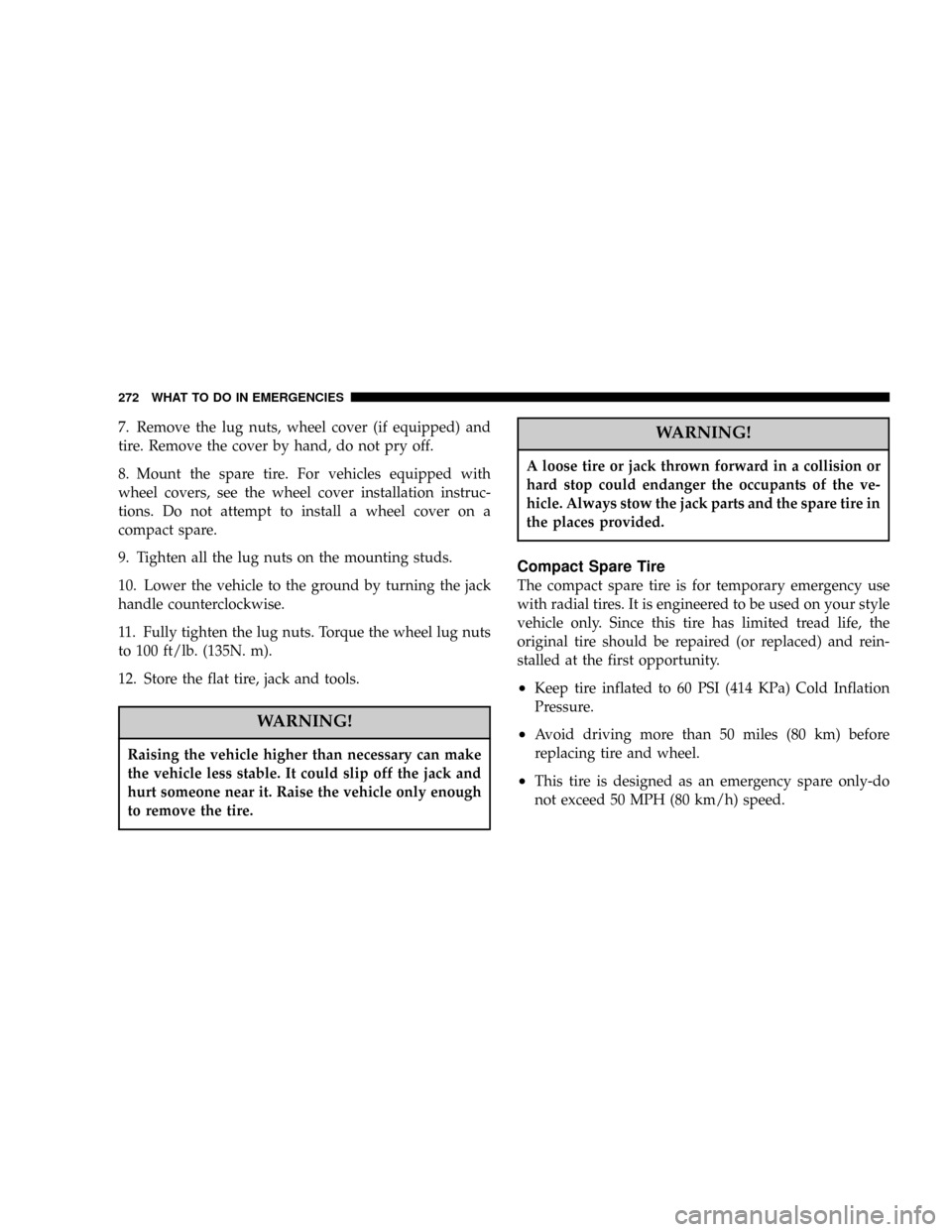Page 241 of 374

Tread Wear Indicators
Tread wear indicators are in the original equipment tires
to help you in determining when your tires should be
replaced.
These indicators are molded into the bottom of the tread
grooves and will appear as bands when the tread depth
becomes 1/16 inch (2 mm). When the indicators appear
in 2 or more adjacent grooves, the tire should be replaced.
Many states have laws requiring tire replacement at this
point.
Replacement Tires
The tires on your new vehicle provide a balance of many
characteristics. They should be inspected regularly for
wear and correct cold tire inflation pressure. The manu-
facturer strongly recommends that you use tires equiva-
lent to the originals in size, quality and performance
when replacement is needed (see the paragraph on tread
wear indicators). Refer to the Tire and Loading Informa-
tion placard for the size designation of your tire. The
service description and load identification will be found
on the original equipment tire. Failure to use equivalent
replacement tires may adversely affect the safety, han-
dling, and ride of your vehicle. We recommend that you
contact your original equipment or an authorized tire
dealer with any questions you may have on tire specifi-
cations or capability.
STARTING AND OPERATING 241
5
Page 246 of 374

NOTE:For vehicles with optional wheel/tire sizes and
significantly different tire placard pressures, the placard
pressure value and the low-pressure threshold value is
re-programmable at your authorized dealer to accommo-
date the customer selected wheel/tire combinations rec-
ommended by DaimlerChrysler.
The following9warnings9will cause a text message to be
displayed, an audible chime to sound and the tire pres-
sure Indicator Lamp to illuminate. The audible chime
will occur once every ignition cycle for each9warning9
detected. The tire pressure Indicator Lamp will illumi-
nate continuously (solid) and shall remain illuminated
until the warning condition is removed/reset.
NOTE:The Indicator Lamp will only illuminate for the
four active road tires. A low spare tire pressure will not
cause the Indicator Lamp to illuminate
When the appropriate conditions exist, the Electronic
Vehicle Information Center (EVIC) displays the following
messages.
LEFT FRONT, LEFT REAR, RIGHT FRONT,
RIGHT REAR LOW PRESSURE
One or more of these messages will be displayed in the
EVIC if a low tire pressure condition exists in one or more
tires.
Inspect all tires for proper inflation pressure, once the
proper tire pressure has been set, the TPM system
warning will reset automatically when the vehicle has
been driven for at least 2 minutes at or above 15 mph (24
km/h).
CHECK TPM SYSTEM
See your authorized dealer when this message appears in
the EVIC. This message indicates that a system fault
condition has been detected.
246 STARTING AND OPERATING
Page 272 of 374

7. Remove the lug nuts, wheel cover (if equipped) and
tire. Remove the cover by hand, do not pry off.
8. Mount the spare tire. For vehicles equipped with
wheel covers, see the wheel cover installation instruc-
tions. Do not attempt to install a wheel cover on a
compact spare.
9. Tighten all the lug nuts on the mounting studs.
10. Lower the vehicle to the ground by turning the jack
handle counterclockwise.
11. Fully tighten the lug nuts. Torque the wheel lug nuts
to 100 ft/lb. (135N. m).
12. Store the flat tire, jack and tools.
WARNING!
Raising the vehicle higher than necessary can make
the vehicle less stable. It could slip off the jack and
hurt someone near it. Raise the vehicle only enough
to remove the tire.
WARNING!
A loose tire or jack thrown forward in a collision or
hard stop could endanger the occupants of the ve-
hicle. Always stow the jack parts and the spare tire in
the places provided.
Compact Spare Tire
The compact spare tire is for temporary emergency use
with radial tires. It is engineered to be used on your style
vehicle only. Since this tire has limited tread life, the
original tire should be repaired (or replaced) and rein-
stalled at the first opportunity.
²Keep tire inflated to 60 PSI (414 KPa) Cold Inflation
Pressure.
²Avoid driving more than 50 miles (80 km) before
replacing tire and wheel.
²This tire is designed as an emergency spare only-do
not exceed 50 MPH (80 km/h) speed.
272 WHAT TO DO IN EMERGENCIES
Page 372 of 374

Engine Fails to Start................... 208
Starting and Operating................... 207
Steering
Linkage............................ 301
Power...........................227,300
Tilt Column......................... 109
Wheel, Tilt.......................... 109
Steering Wheel Mounted Sound System
Controls............................ 190
Storage...........................130,321
Storage, Vehicle.....................203,321
Storing Your Vehicle..................... 321
Sulfur in Gasoline...................... 252
Sun Roof............................. 124
Sunglass Storage....................... 118
Supplemental Restraint System - Airbag....... 37
Tachometer........................... 141
Telescoping Steering Column.............. 109
Temperature Control, Automatic............ 197
Temperature Gauge, Engine Coolant......143,265
Theft Alarm............................ 24
Theft System........................... 24Tie Down Hooks, Cargo.................. 131
Tilt Steering Column.................... 109
Tire and Loading Information Placard....... 232
Tire Identification Number (TIN)........... 231
Tire Markings......................... 228
Tire Safety Information................... 228
Tires ...........................59,236,358
Air Pressure......................... 236
Alignment.......................... 242
Chains............................. 248
Changing........................265,269
Compact Spare....................... 239
Flat Changing........................ 265
General Information................... 236
High Speed......................... 238
Inflation Pressures.................... 237
Jacking..........................266,269
Load Capacity....................232,233
Pressure Monitor System............... 243
Quality Grading...................... 358
Radial............................. 239
Replacement......................... 241
Rotation............................ 249
372 INDEX